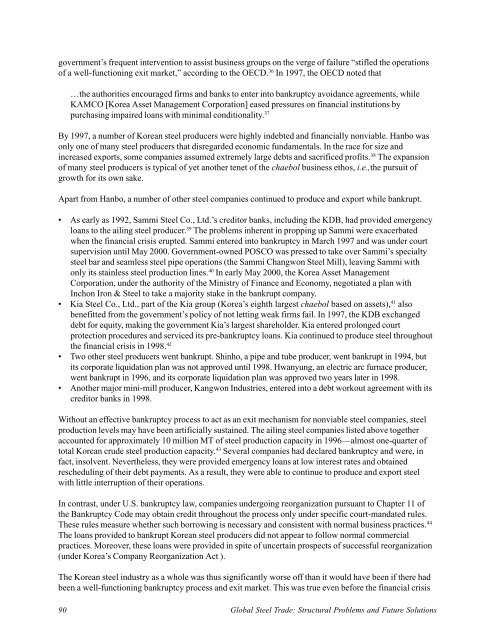Global Steel Trade; Structural Problems and Future Solutions
Global Steel Trade; Structural Problems and Future Solutions
Global Steel Trade; Structural Problems and Future Solutions
You also want an ePaper? Increase the reach of your titles
YUMPU automatically turns print PDFs into web optimized ePapers that Google loves.
government’s frequent intervention to assist business groups on the verge of failure “stifled the operations<br />
of a well-functioning exit market,” according to the OECD. 36 In 1997, the OECD noted that<br />
…the authorities encouraged firms <strong>and</strong> banks to enter into bankruptcy avoidance agreements, while<br />
KAMCO [Korea Asset Management Corporation] eased pressures on financial institutions by<br />
purchasing impaired loans with minimal conditionality. 37<br />
By 1997, a number of Korean steel producers were highly indebted <strong>and</strong> financially nonviable. Hanbo was<br />
only one of many steel producers that disregarded economic fundamentals. In the race for size <strong>and</strong><br />
increased exports, some companies assumed extremely large debts <strong>and</strong> sacrificed profits. 38 The expansion<br />
of many steel producers is typical of yet another tenet of the chaebol business ethos, i.e.,the pursuit of<br />
growth for its own sake.<br />
Apart from Hanbo, a number of other steel companies continued to produce <strong>and</strong> export while bankrupt.<br />
• As early as 1992, Sammi <strong>Steel</strong> Co., Ltd.’s creditor banks, including the KDB, had provided emergency<br />
loans to the ailing steel producer. 39 The problems inherent in propping up Sammi were exacerbated<br />
when the financial crisis erupted. Sammi entered into bankruptcy in March 1997 <strong>and</strong> was under court<br />
supervision until May 2000. Government-owned POSCO was pressed to take over Sammi’s specialty<br />
steel bar <strong>and</strong> seamless steel pipe operations (the Sammi Changwon <strong>Steel</strong> Mill), leaving Sammi with<br />
only its stainless steel production lines. 40 In early May 2000, the Korea Asset Management<br />
Corporation, under the authority of the Ministry of Finance <strong>and</strong> Economy, negotiated a plan with<br />
Inchon Iron & <strong>Steel</strong> to take a majority stake in the bankrupt company.<br />
• Kia <strong>Steel</strong> Co., Ltd., part of the Kia group (Korea’s eighth largest chaebol based on assets), 41 also<br />
benefitted from the government’s policy of not letting weak firms fail. In 1997, the KDB exchanged<br />
debt for equity, making the government Kia’s largest shareholder. Kia entered prolonged court<br />
protection procedures <strong>and</strong> serviced its pre-bankruptcy loans. Kia continued to produce steel throughout<br />
the financial crisis in 1998. 42<br />
• Two other steel producers went bankrupt. Shinho, a pipe <strong>and</strong> tube producer, went bankrupt in 1994, but<br />
its corporate liquidation plan was not approved until 1998. Hwanyung, an electric arc furnace producer,<br />
went bankrupt in 1996, <strong>and</strong> its corporate liquidation plan was approved two years later in 1998.<br />
• Another major mini-mill producer, Kangwon Industries, entered into a debt workout agreement with its<br />
creditor banks in 1998.<br />
Without an effective bankruptcy process to act as an exit mechanism for nonviable steel companies, steel<br />
production levels may have been artificially sustained. The ailing steel companies listed above together<br />
accounted for approximately 10 million MT of steel production capacity in 1996—almost one-quarter of<br />
total Korean crude steel production capacity. 43 Several companies had declared bankruptcy <strong>and</strong> were, in<br />
fact, insolvent. Nevertheless, they were provided emergency loans at low interest rates <strong>and</strong> obtained<br />
rescheduling of their debt payments. As a result, they were able to continue to produce <strong>and</strong> export steel<br />
with little interruption of their operations.<br />
In contrast, under U.S. bankruptcy law, companies undergoing reorganization pursuant to Chapter 11 of<br />
the Bankruptcy Code may obtain credit throughout the process only under specific court-m<strong>and</strong>ated rules.<br />
These rules measure whether such borrowing is necessary <strong>and</strong> consistent with normal business practices. 44<br />
The loans provided to bankrupt Korean steel producers did not appear to follow normal commercial<br />
practices. Moreover, these loans were provided in spite of uncertain prospects of successful reorganization<br />
(under Korea’s Company Reorganization Act ).<br />
The Korean steel industry as a whole was thus significantly worse off than it would have been if there had<br />
been a well-functioning bankruptcy process <strong>and</strong> exit market. This was true even before the financial crisis<br />
90 <strong>Global</strong> <strong>Steel</strong> <strong>Trade</strong>: <strong>Structural</strong> <strong>Problems</strong> <strong>and</strong> <strong>Future</strong> <strong>Solutions</strong>
















